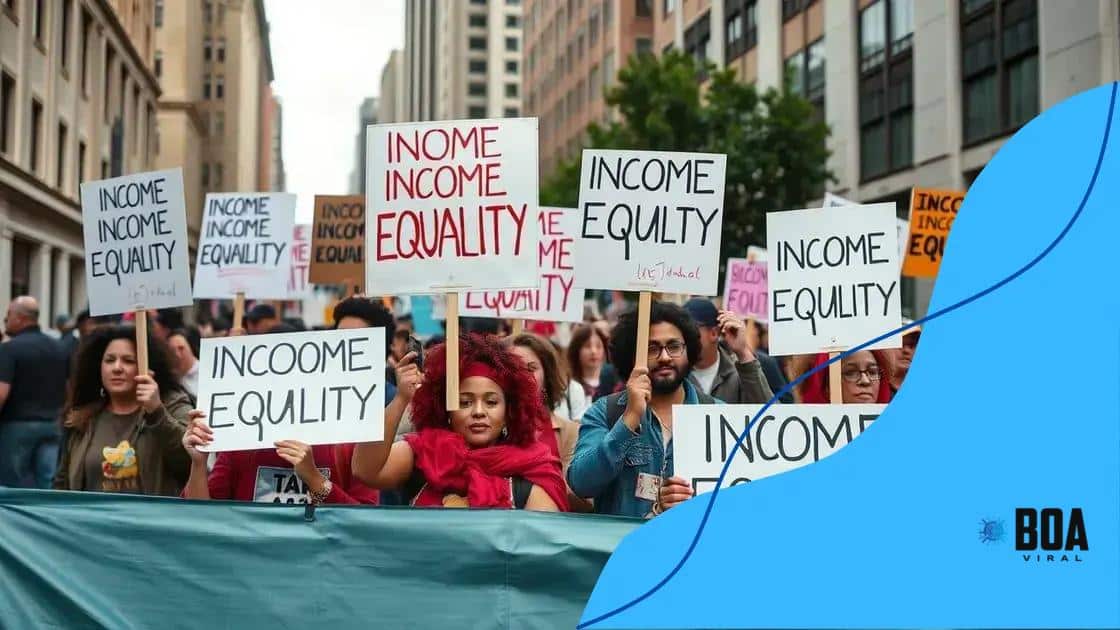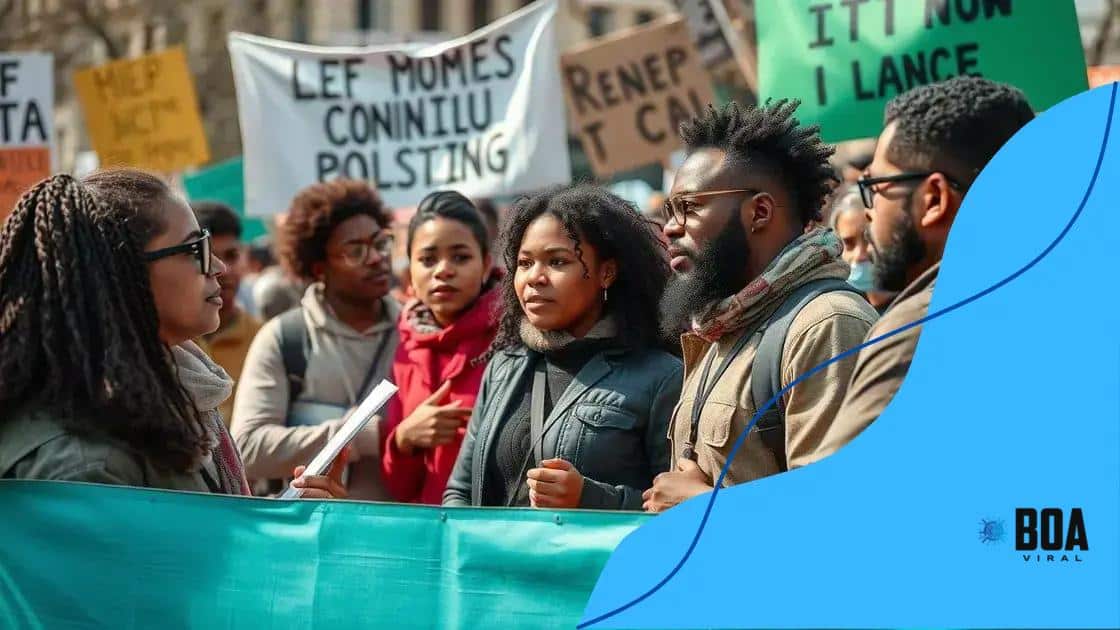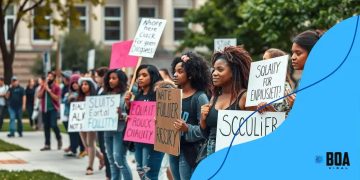Income inequality protest campaigns: a closer look

Income inequality protests aim to address the unequal distribution of wealth and advocate for social justice, leveraging strategies like social media mobilization and grassroots organizing to drive change.
Income inequality protest campaigns are at the forefront of social movements today. As disparities grow, voices rise, demanding change and equity. Have you ever wondered how these protests shape our society?
Understanding income inequality
Understanding income inequality is crucial for grasping the challenges many face today. It refers to the uneven distribution of wealth in society, where a small percentage holds a significant portion of resources.
This issue affects millions worldwide, leading to various social and economic problems. As we delve deeper, we discover the factors contributing to this disparity.
Key Causes of Income Inequality
Several reasons contribute to income inequality, including:
- Educational disparities that limit job opportunities.
- The influence of technology that favors skilled labor.
- Differences in regional economic development.
These factors create a cycle that’s hard to break. For instance, individuals with less education often find themselves stuck in low-paying jobs. In contrast, those with advanced degrees have access to higher income positions.
Effects on Society
The consequences of income inequality can be alarming. High levels of inequality can impact social mobility, weaken community bonds, and lead to increased crime rates. It can also foster feelings of resentment and division among different economic classes.
Society as a whole suffers when wealth is concentrated in the hands of a few. It stifles growth and innovation, making it harder for everyone to succeed. By recognizing these issues, we can better understand the importance of addressing income inequality.
Historic movements for income equality
Historic movements for income equality have shaped society in significant ways. Throughout history, various groups have come together to fight against economic injustice. These movements have often sparked change and raised awareness about critical issues.
One notable example is the labor movement, which began in the late 19th century. Workers organized to demand fair wages and better working conditions. This push for rights led to significant reforms that aimed to reduce income inequality.
The Civil Rights Movement
Another crucial time was during the Civil Rights Movement in the 1960s. Activists not only fought for racial equality but also highlighted economic disparities. They emphasized that true equality cannot exist without equal access to economic opportunities.
- Some key figures included Martin Luther King Jr., who addressed income issues in his speeches.
- The movement paved the way for legislation aimed at reducing economic gaps.
- Many protests highlighted the importance of both social and economic justice.
In more recent years, movements like Occupy Wall Street have drawn attention to the wealth gap, using slogans like “We are the 99%” to illustrate the disparities in wealth. Such movements challenge the status quo, advocating for policies that promote a fairer distribution of resources.
By studying these historic movements, we can glean insights into how activism has evolved. Each movement brought unique strategies and demands, but they all shared a common goal: fighting against income inequality.
Key strategies in protest campaigns

Key strategies in protest campaigns are essential for effective activism. These strategies help movement leaders organize support, communicate messages, and drive change. Understanding these approaches is vital for anyone looking to contribute positively to the cause of income inequality.
One major strategy involves community organizing. This includes working with local leaders and residents to identify shared goals. By uniting diverse groups, campaigns can strengthen their message and increase their impact.
Effective Messaging
Another crucial element is crafting powerful messages. These messages need to resonate with the public, often through:
- Clear and relatable language that explains the issue.
- Using emotional appeals to connect with people’s experiences.
- Highlighting stories of those affected by income inequality.
By employing these techniques, campaigns can raise awareness and motivate individuals to take action. Social media plays a significant role in spreading these messages quickly and widely, allowing campaigns to reach larger audiences.
Building Coalitions
Coalition-building is also important. Different groups can come together to amplify their voices, providing a united front against income inequality. Collaborating with other organizations can lead to:
- Shared resources and knowledge.
- Increased reach and credibility.
- More substantial advocacy efforts.
Utilizing direct action tactics, such as peaceful protests and demonstrations, can also draw attention to critical issues. These actions often spark conversations and urge policymakers to consider the demands of the public.
The role of social media in activism
The role of social media in activism has become increasingly important in recent years. Platforms like Twitter, Facebook, and Instagram allow activists to reach a wide audience quickly. They enable individuals to share information, organize events, and mobilize support for various causes.
One key aspect of using social media is its ability to create a sense of community among supporters. Activists can join together online, sharing stories and experiences that resonate with many people. This connection helps to inspire others to get involved and advocate for income equality.
Spreading Awareness
Social media campaigns can also spread awareness rapidly. Hashtags like #IncomeInequality or #FightFor15 have brought attention to critical issues. These hashtags not only unify a message but also make it easier for others to join the conversation.
- They help keep the public informed about ongoing events.
- These campaigns can highlight personal stories that put a face to the issue.
- Visual content, such as infographics and videos, can engage users more effectively.
Additionally, social media allows for real-time updates during protests and events. Activists can share live footage or posts, helping to amplify their voices. This instant feedback can also guide future actions.
Challenges and Risks
Despite its advantages, using social media in activism has challenges. Misinformation can spread quickly, creating confusion around important issues. Activists must be vigilant to ensure that the information shared is accurate and credible.
Moreover, online activism, often referred to as “slacktivism,” can lead to complacency. Some might feel that sharing a post is enough action, while real change requires more. Balancing online activities with offline actions is essential for effective activism.
Future of income inequality protests
The future of income inequality protests looks promising as new generations take up the cause. With increased awareness of social issues, many young activists are stepping forward to demand change. Their strategies often blend traditional protest methods with innovative techniques, adapting to modern times.
One likely trend is the continued use of social media.
Engagement through Technology
Activists will use platforms like TikTok and Instagram to engage younger audiences. These platforms offer creative ways to spread messages quickly and effectively. Campaigns can go viral, reaching millions almost instantly.
- This allows for diverse storytelling that resonates with more people.
- Visual content can simplify complex issues, making them more understandable.
- Live streaming events can capture real-time participation, showing the solidarity of the movement.
Moreover, technology can enhance organizing efforts. Apps for event management, fundraising, and volunteer coordination streamline the process. This efficiency empowers activists to focus more on the message and less on logistics.
Grassroots Movements
We can also expect that grassroots movements will continue to play a crucial role. Local protests often spark larger national campaigns. Community-driven efforts foster connections among individuals, encouraging collective action. When communities support each other, they can challenge the status quo more effectively.
Additionally, as economic disparities grow, social justice movements may gain even more urgency. Issues like affordable housing, healthcare access, and fair wages will likely drive protests. The voices of those affected will be central to upcoming actions.
As more people become aware of the effects of income inequality, the protests will evolve. Partnerships between established organizations and new activists will strengthen the overall movement. Together, they can continue fighting for a fairer future.
FAQ – Frequently Asked Questions about Income Inequality Protests
What are income inequality protests?
Income inequality protests are movements advocating for fair wealth distribution and equitable opportunities for all individuals in society.
How has social media influenced these protests?
Social media has amplified the voices of activists, allowing them to organize, spread awareness, and connect with a broader audience rapidly.
What strategies do activists use in these protests?
Activists often use strategies like community organizing, effective messaging, live events, and grassroots movements to advocate for change.
What is the future of income inequality protests?
The future looks bright as new generations embrace technology and grassroots efforts to continue fighting for equality and social justice.






